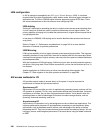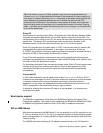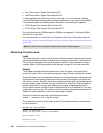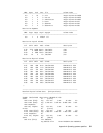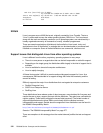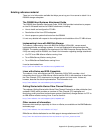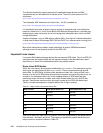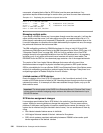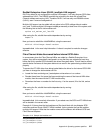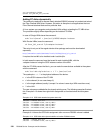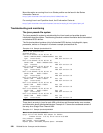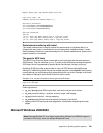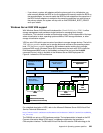
316 DS6000 Series: Concepts and Architecture
commands, all special device files for SCSI disks have the same permissions. If an
application requires different settings for certain disks, you have to correct them afterwards.
Example: A-11 Duplicating the permissions of special device files
knox:~ # ls -l /dev/sda /dev/sda1
rw-rw---- 1 root disk 8, 0 2003-03-14 14:07 /dev/sda
rw-rw---- 1 root disk 8, 1 2003-03-14 14:07 /dev/sda1
knox:~ # chmod 660 /dev/sd*
knox:~ # chown root:disk /dev/sda*
Managing multiple paths
If you assign a DS6000 volume to a Linux system through more than one path, it will see the
same volume more than once. It will also assign more than one special device file to it. To
utilize the path redundancy and increased I/O bandwidth, you need an additional layer in the
Linux disk subsystem to recombine the multiple disks seen by the system into one, to manage
the paths and to balance the load across them.
The IBM multipathing solution for DS6000 attachment to Linux on Intel IA-32 and IA-64
architectures, IBM pSeries and iSeries is the IBM Subsystem Device Driver (SDD) (see 14.2,
“Subsystem Device Driver” on page 280). SDD for Linux is available in the Linux RPM
package format for all supported distributions from the SDD download site. It is proprietary
and binary only. It only works with certain kernel versions with which it was tested. The
README file on the SDD for Linux download page contains a list of the supported kernels.
The version of the Linux Logical Volume Manager that comes with all current Linux
distributions does not support its physical volumes being placed on SDD vpath devices.
SDD is not available for Linux on zSeries. SUSE Linux Enterprise Server 8 for zSeries comes
with built-in multipathing provided by a patched Logical Volume Manager. Today there is no
multipathing support for Redhat Enterprise Linux for zSeries.
Limited number of SCSI devices
Due to the design of the Linux SCSI I/O subsystem in the Linux Kernel version 2.4, the
number of SCSI disk devices is limited to 256. Attaching devices through more than one path
reduces this number. If, for example, all disks were attached through 4 paths, only up to 64
disks could be used.
SCSI device assignment changes
Linux assigns special device files to SCSI disks in the order they are discovered by the
system. Adding or removing disks can change this assignment. This can cause serious
problems if the system configuration is based on special device names (for example, a file
system that is mounted using the /dev/sda1 device name). You can avoid some of them by
using:
Disk Labels instead of device names in /etc/fstab
LVM Logical Volumes instead of /dev/sd.. devices for file systems
SDD, which creates a persistent relationship between a DS6000 volume and a vpath
device regardless of the /dev/sd.. devices
Important: The latest update to the SUSE Linux Enterprise Server 8, Service Pack 3 uses
a more dynamic method of assigning major numbers and allows the attachment of up to
2304 SCSI devices.



